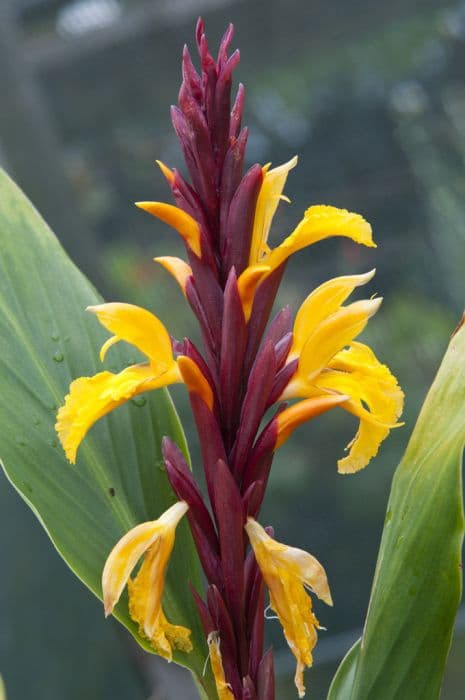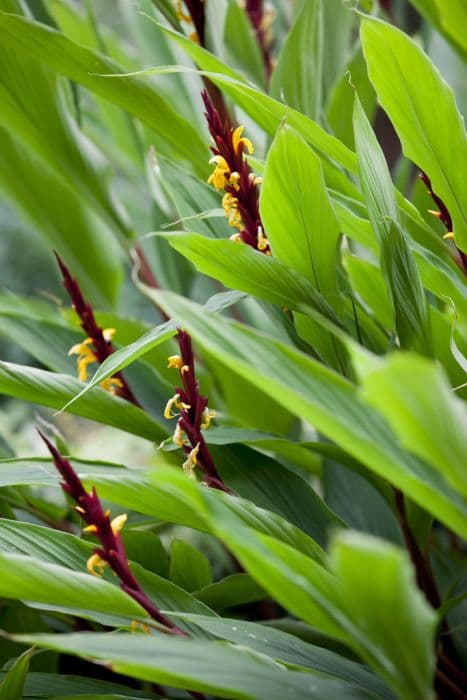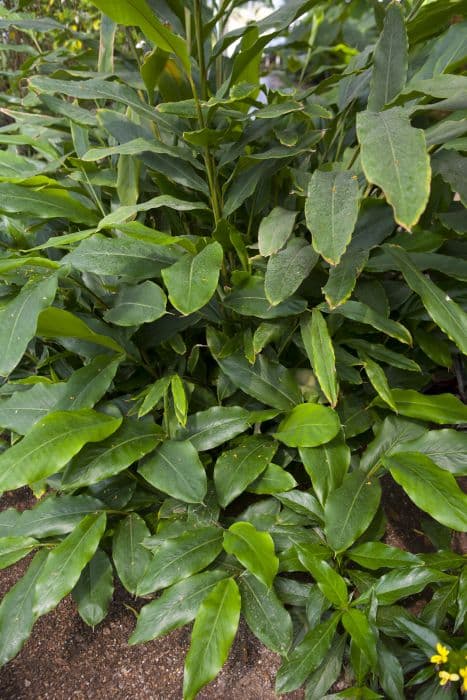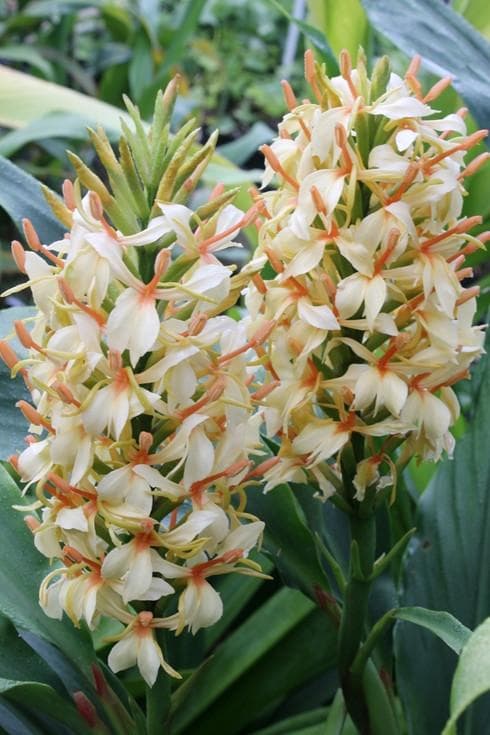Ginger Lily Hedychium densiflorum 'Assam Orange'

ABOUT
Hedychium densiflorum 'Assam Orange', commonly known as Assam Orange Ginger Lily, features striking, bright orange flowers which are densely packed on a spike-like inflorescence. These blossoms exude a pleasant fragrance and tend to attract pollinators such as butterflies and hummingbirds. The flowers are complemented by lance-shaped, deep green leaves that create a lush tropical appearance. The foliage has a slightly glossy finish and an arching growth habit, providing a graceful backdrop for the vivid floral display. The Assam Orange Ginger Lily has a rhizomatous root system from which new shoots emerge, contributing to the plant's overall lushness.
About this plant
 Names
NamesFamily
Zingiberaceae.
Synonyms
Assam Orange Ginger Lily, Orange Bottlebrush Ginger, Dense-Flowering Ginger.
Common names
Hedychium densiflorum
 Toxicity
ToxicityTo humans
The Hedychium densiflorum 'Assam Orange', commonly known as ginger lily, generally is not considered highly toxic to humans. However, as with many plants, it may cause irritation or an allergic reaction when handled or ingested by sensitive individuals. If ingested in large quantities, it might lead to mild stomach upset. It is always advisable to exercise caution and keep plants out of reach of children who might ingest them out of curiosity.
To pets
The Hedychium densiflorum 'Assam Orange', commonly known as ginger lily, is not listed as a highly toxic plant to pets such as dogs and cats. However, the ingestion of any plant material may cause mild gastrointestinal upset in some pets. Symptoms of plant toxicity in pets can include vomiting, diarrhea, drooling, or difficulty swallowing. If a pet ingests a large amount of the ginger lily plant and displays symptoms, it is recommended to consult a veterinarian.
 Characteristics
CharacteristicsLife cycle
Perennials
Foliage type
Deciduous
Color of leaves
Green
Flower color
Orange
Height
6 feet (1.8 meters)
Spread
2 feet (0.6 meters)
Plant type
Herb
Hardiness zones
8
Native area
Himalayas
Benefits
 General Benefits
General Benefits- Aesthetic Appeal: Adds a tropical flair to gardens with its vibrant orange flowers.
- Attracts Pollinators: Provides nectar for bees, butterflies, and other pollinating insects.
- Easy to Grow: Tolerant of various soil types and relatively low maintenance.
- Fragrance: The flowers emit a pleasant fragrance, which can enhance the sensory experience in a garden.
- Fast Growing: Can quickly fill garden spaces and establish itself without extensive care.
- Privacy Screening: Dense foliage makes it ideal for creating natural privacy barriers.
- Seasonal Interest: Blooms in late summer to early fall, providing color when many other plants have finished flowering.
- Garden Design: Can be used as a focal point or background plant in garden beds and borders.
- Container Gardening: Suitable for planting in containers, thus versatile for patios and smaller spaces.
 Medical Properties
Medical PropertiesThis plant is not used for medical purposes.
 Air-purifying Qualities
Air-purifying QualitiesThis plant is not specifically known for air purifying qualities.
 Other Uses
Other Uses- Garden Borders: Hedychium densiflorum 'Assam Orange' can be used to create vibrant edges along garden beds, adding a splash of color and texture with its striking flowers and foliage.
- Cut Flowers: The bright orange blooms make excellent cut flowers for indoor arrangements, bringing a tropical touch to floral displays.
- Container Gardening: It can be grown in pots or large containers, ideal for people with limited garden space or who want to add an exotic flair to their patio or balcony.
- Natural Dye: The flowers and roots could potentially be used to obtain natural dyes for fabric or crafts, although this is not a common application.
- Privacy Screening: With its dense growth habit, this plant can be used to create a natural privacy screen in the garden or along the property borders.
- Photography Prop: The striking flowers and tropical appearance can serve as an excellent background or subject for garden and nature photography.
- Companion Planting: Hedychium densiflorum 'Assam Orange' can be planted alongside other perennials to create a complementary color palette and a diverse habitat for beneficial insects.
- Landscape Design: The vibrant orange flowers can be used to create a focal point or to add visual interest to a monochrome landscape.
- Educational Use: It can be a great plant to teach about pollination and the attraction of butterflies and hummingbirds in educational gardens.
- Perfumery: The fragrant flowers may be used for creating natural scents or perfumes, although this application is less common and may require specialized extraction methods.
Interesting Facts
 Feng Shui
Feng ShuiThe plant_name is not used in Feng Shui practice.
 Zodiac Sign Compitability
Zodiac Sign CompitabilityThe plant_name is not used in astrology practice.
 Plant Symbolism
Plant Symbolism- Tropical Exuberance: The Hedychium densiflorum 'Assam Orange', also known as Orange Ginger Lily, is native to tropical regions, symbolizing lushness and vibrancy found in exotic landscapes.
- Warmth and Hospitality: Its bright orange blooms are reminiscent of the warmth of a hearth or the sun, commonly representing a welcoming environment and open-heartedness.
- Sensual Allure: The fragrant flowers of the Orange Ginger Lily are often associated with sensuality and the allure of the unknown, hinting at hidden depths and passions.
- Exotic Beauty: Its unique appearance and rare occurrence in temperate gardens often symbolize beauty that is striking and out of the ordinary.
 Water
WaterThe Ginger Lily should be watered regularly, ensuring the soil is moist but not waterlogged. During the active growing season in spring and summer, this normally translates to watering once every five to seven days, providing about 1 to 2 gallons per week, depending on the size of the plant and the weather conditions. Less frequent watering is needed during the dormant period in the fall and winter, roughly halving the summer amount. It's crucial not to overwater as Ginger Lilies do not like to sit in waterlogged soil, which can lead to root rot. Always check the top inch of soil for dryness before watering again.
 Light
LightGinger Lilies thrive in bright, indirect light or partial shade. The ideal spot would be a location where the plant receives several hours of morning sunlight but is protected from the harsh afternoon sun. Ginger Lilies can tolerate full sun in cooler climates, but in hotter regions, they should be placed where they can be shaded during the peak sun hours to prevent scorching.
 Temperature
TemperatureGinger Lilies prefer warm temperatures and do not tolerate frost well. The ideal temperature range for this plant is between 60°F to 80°F. They can survive minimum temperatures down to about 50°F, but for optimal health and flowering, keeping them in the recommended temperature range is best. Be aware of sudden temperature drops and provide protection if temperatures are expected to fall below the minimum threshold.
 Pruning
PruningPrune Ginger Lilies to remove spent flowers and dead foliage, and to encourage healthier growth and blooming. The best time to prune is in the late winter or early spring before new growth begins. Pruning can be done as needed throughout the year to maintain plant shape and remove dead or damaged plant parts.
 Cleaning
CleaningAs needed
 Soil
SoilThe best soil mix for Ginger Lily should be rich, well-draining and loamy with a pH between 6.0 and 6.8. Amend the garden soil with compost or a mixture of peat, perlite, and pine bark to improve texture and fertility.
 Repotting
RepottingGinger Lily should be repotted every 2-3 years or when it becomes root-bound. Early spring, just before the growing season begins, is the ideal time for repotting.
 Humidity & Misting
Humidity & MistingGinger Lily thrives in high humidity conditions, ideally between 60% and 80%. Avoid placing it in dry environments, and consider using a humidifier if indoor humidity is low.
 Suitable locations
Suitable locationsIndoor
Place in bright, indirect light and keep soil consistently moist.
Outdoor
Plant in partial shade, fertile soil, and mulch to retain moisture.
Hardiness zone
8-10 USDA
 Life cycle
Life cycleGinger Lily 'Assam Orange' begins its life cycle as a rhizome, where it undergoes a period of dormancy typically during the colder months. Upon the arrival of warm weather and with adequate moisture, new shoots emerge from the rhizome and develop into stems with lance-shaped leaves. The plant continues to grow, reaching full maturity and height during the summer, when it produces dense spikes of fragrant, bright orange flowers. After pollination, which can occur via insects, the flowers may produce seed capsules containing seeds, which can be dispersed to grow new plants. As temperatures cool, the aerial parts of the Ginger Lily die back to the ground, and the plant re-enters a phase of dormancy, drawing energy from the rhizome to survive the winter. With the return of favorable conditions in the following growing season, the cycle resumes with the rhizome sprouting new growth.
 Propogation
PropogationPropogation time
Spring-Early Summer
The most popular method of propagation for Hedychium densiflorum 'Assam Orange', commonly known as the Assam Orange ginger lily, is by division of rhizomes. The ideal time to propagate this plant is in the spring after the last frost has passed when the plant begins to emerge from dormancy. To propagate, dig up the rhizomes carefully and use a clean, sharp knife to divide them, ensuring that each section has at least one growth bud. Replant the divisions at the same depth they were growing at originally, spacing them about 15 to 24 inches (approximately 38 to 61 centimeters) apart. Water the new plants well and maintain moist but not waterlogged soil as they establish.









